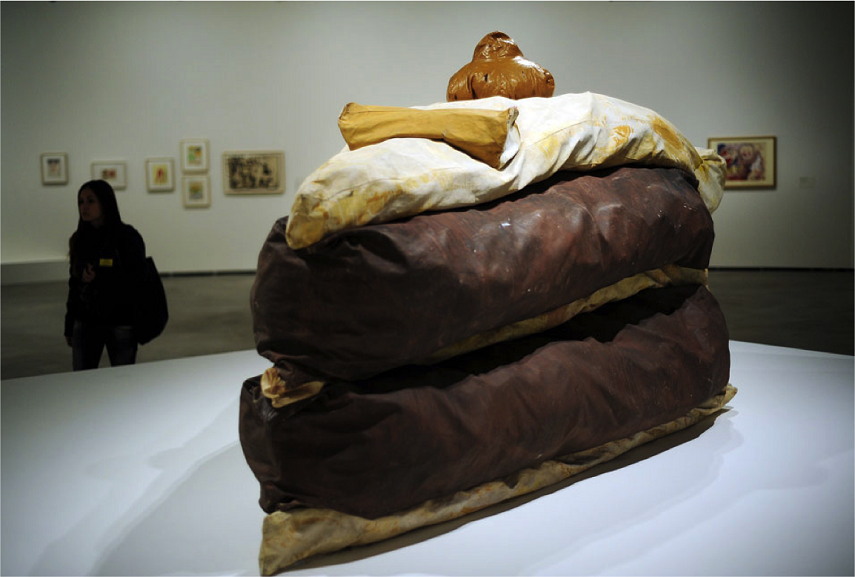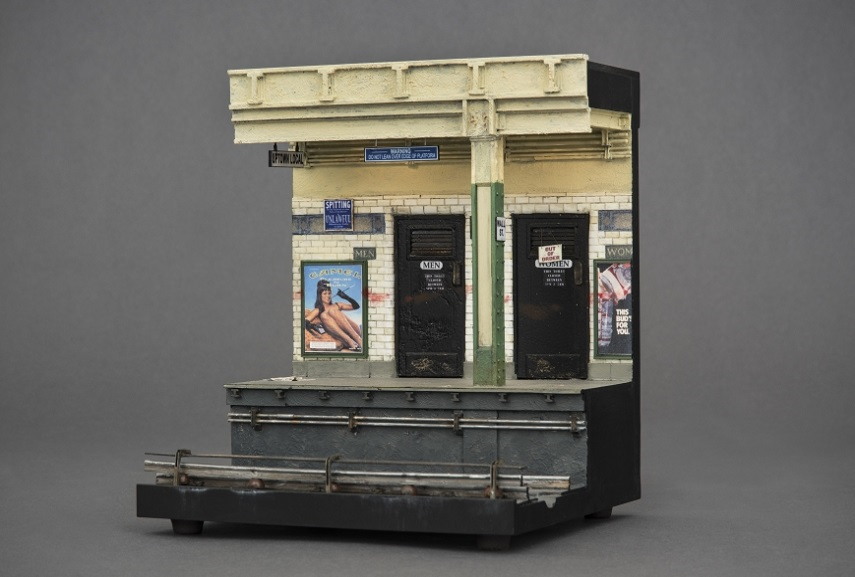Beach Views Tumblr to Draw With Color Examples of Color in the Elements of Art
How practice we perceive scale in fine art? Enormous plastic ice foam, huge balloon dogs, or enlarged photo portraits plastered on buildings effectually the earth are some of the examples where calibration in art is the dominant element of the artworks' aesthetics. Scale refers to a size of an object in relation to some other, and is one of the principles of organization of structural elements in art and pattern. Scale in art does non stand for the size of an artwork only is a relational principle which is usually defined through the ratio of an object to a human torso or another object.[1] Relational aesthetics stands at cadre of each artwork and human body is often the cosmetic against which the size of each piece can be discussed. Equally humans put themselves in the center of the visible world, as masters of the living environments, artworks are measured regarding proportion relative to the generalized human scale. They became defined as big, life-size, miniature, or fifty-fifty enormous. The scale in fine art is thus something that is habitually examined and is often an important factor in defining the meaning and significance of each work, peculiarly in contemporary art.
The Decisions Behind Calibration in Fine art
Different scaling is applied in art when something needs to exist emphasized, or when through disproportionate size the importance of the represented is underlined. This does not mean that we are constantly bombarded with works that have unusual scaling patterns, but that calibration in art is an essential chemical element that is present and idea out fifty-fifty in works that at commencement observation do not seem to stand up out regarding this element. Paying attending to and elaborating on scale in art therefore becomes an of import aspect of any creative evaluation and criticism. Exploring how calibration in art influences viewing experience through examples, we volition see that artists' decisions on the calibration of their works are based on the represented motifs, cultural traditions and the message they are trying to convey. Sometimes this message may non surpass the pure aesthetic enjoyment in each piece, simply fifty-fifty in these circumstances, scale is carefully decided on.

Upscaling Pop Art - Claes Oldenburg
One of the leading figures of Popular Fine art, Claes Oldenburg started experimenting with scale in fine art in early 1960s, inspired by midtown showrooms on Manhattan displaying grand pianos and luxury cars. His exhibition in 1962 at the Green Gallery in New York showcased for the kickoff time his soft sculptures created with the aid of his and so-married woman Patty Mucha, who made his sculptures from fabrics. Pliant cloth of Flooring Burger, Floor Cake, and Floor Cone, to mention a few, was a groundbreaking moment in sculptural history transgressing its postulates of compactness and rigidity. The choice of motifs he represented in jumbo scales, such as everyday food, brought humor and whimsy in high art and opened upwardly the field of sculpture to subjects from everyday American life. Equally the creative person stated: "my art is made for human beings, and it'southward of import that people enjoy the experience of seeing information technology."[2]
Encounter more works by Claes Oldenburg here!
He connected his practice in this field over the years, and moved away from galleries to open spaces where his sculpture reached truly gigantic proportions such as in Dropped Cone or Shuttlecocks. Again playing with scale in art, these works were created in collaboration with his second wife Coosje van Bruggen. Past enlarging ordinary objects to enormous proportions, Oldenburg shrinks the viewers, reversing in this mode the traditional human relationship between the viewers and the observed objects. His oversized sculptures as well possess a disquisitional border showing an insight on American culture and aiming at its absurdities.
Shahzia Sikander'south Monumental Miniatures and Gigantic Videos
Miniatures are one of the fine art genres where calibration is divers by the purpose of the works. Created in different periods and meridians they appeared in votive and religious books, such as illuminated medieval manuscripts, simply portraits and paintings were also occasionally fabricated in miniature. A Pakistani-born creative person Shahzia Sikander is one among the contemporary creatives who experiments with such artistic traditions and use scale to re-proportion the symbolic meanings such works inherently have. Her interest, amongst others, lies with Persian miniatures which represented religious or mythological themes. Even though Islam forbids figurative representations, in small-scale art made for private employ such prohibitions were often ignored.
The Gopi women hairdos that are disembodied and seem to float and swirl into a Mughal court are ane of her early on motifs she used in big-calibration video SpiNN (2003) and many miniature paintings earlier. Fascinated with their aesthetics that "had this wonderful silhouette… that could look like bats or birds" she continued to experiment with them, driven primarily past the interest in conceptual "distance betwixt the translation and the original…of examining a style, school, genre, and developing a relationship, a linguistic communication, a dialogue with it." [3] Sikander finds inspiration in the past, which she transforms and translates into contemporary genres. Scale of the works she references is encumbered with historical meanings and religious postulates. Nevertheless, in her mixing of history, personal feelings and experience she shifts the perception and challenges the means nosotros meet both her work and the past. Mixing of imagery taken from different historical references, such as, for example, in The Concluding Mail service (2010), where a colonial officeholder of the East India Visitor appears in a Mughal court, creates a visual hybrid in which polarities between Hindu and Muslim, East and West, representation and brainchild seem blurred. The utilise of minor-scale genre in her large-scale videos invites a broader questioning of cultural relationships between the East and the West both in the past and the nowadays.

Scaling Down New York - Miniature Sculptures of Alan Wolfson
In dissimilarity to Shahzia Sikander'south do, Alan Wolfson takes as a reference i of the largest cities in the world, New York, and transforms its gritty reality into sculptural miniatures. Scaling downwards the streets, subway entrances, flats and other elements of the urban surroundings, his primary involvement is in the story behind them: "I'1000 providing you with clues to a narrative, telling a story with infinitesimal details... The existent impact of my piece of work is not in how small everything is but in the stories these small things tell." [four] His dioramas are free of humans, and resemble a contemporary memento mori made in sculpture, where graffiti, trash, or half-eaten nutrient recalls human presence that was once at that place. Past experimenting with scale in art, he too immortalizes spaces and buildings that are lost to gentrification creating in this style a monument to a city that does not exist anymore. By putting such representations in miniature forms, Wolfson pushes for an intimate observation of urban weather created by humans.

Scale in Art - I of Its Crucial Aspects
Scale is essential for the viewing feel, not simply in fine arts, simply also in architecture and other visual media. It defines the meaning of work and is one of the aesthetic elements central to its making and reception. Scale in art questions the part of the viewer and perhaps more other elements directs attention to the relation betwixt a work and location or place. It is ane of the crucial aspects of fine art that affects the reception of each work every bit actual artwork. Every bit seen from examples given above, calibration is used every bit an expressive element that is frequently filled with historical and cultural meanings. Referencing and re-scaling of unlike works and objects infuses the reading of fine art with original interpretations, unencumbered with general theories of earth art, and national and geographical distinctions. Among contemporary artists there are many who play with scale, including some of the all-time known such every bit Jeff Koons. Significance of their works partially comes from unusual scale their works take, which disrupts cultural traditions and viewing practices.
References:
- Lamp L., Design in Art: Scale and Proportion , sophia.org [November 26, 2016]
- McKenna 1000., (1995), Art : When Bigger Is Better : Claes Oldenburg has spent the past 35 years blowing upwardly and redefining everyday objects, all in the proper noun of getting art off its pedestal , articles.latimes.com [Nov 26, 2016]
- Sheets H.G., (2015), Shahzia Sikander: Maximalist Miniatures , artnews.com [November 26, 2016]
- Anonymous, (2015), Alan Wolfson's Miniature New York Sculptures , world wide web.huffingtonpost.com [Nov 26, 2016]
Featured images: Shahzia Sikander - Video Nevertheless from Spinn, 2003. Image via angryasiangirlsunited.tumblr.com; Claes Oldenburg - Sculpture in Minneapolis. Image via pintrest.com; Alan Wolfson - Bay Ridge Subway Archway, 2016. Prototype via hollistaggart.com. All images used for illustrative purposes simply.
Source: https://www.widewalls.ch/magazine/scale-in-art
Belum ada Komentar untuk "Beach Views Tumblr to Draw With Color Examples of Color in the Elements of Art"
Posting Komentar